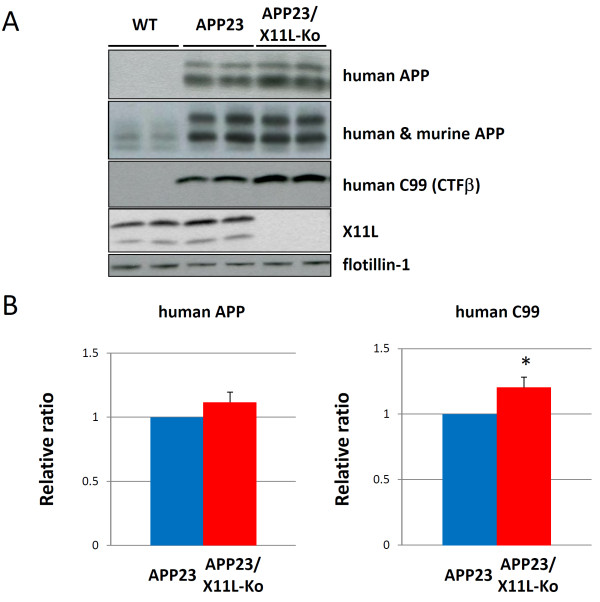Figure 1.
Expression of APP and generation of primary amyloidogenic fragment CTFβ in APP23 mice in the presence or absence of X11L. (A) Expression of human APP751swe and detection of human CTFβ (C99) in APP23 mouse brain samples in the presence or absence of X11L and in wild-type mice. Membrane (P100 for APP, CTFβ and flotillin-1) and cytoplasmic (S100 for X11L) fractions of brain regions composed of the cerebral cortex, hippocampus and olfactory bulb from wild-type (WT), APP23 and APP23/X11L-Ko mice (5-6 months old) were analyzed for the expression of transgenic human APP751swe (anti-APP 10D1 antibody), total APP (human APP751swe combined with mouse endogenous APP695, anti-APP/c 8717 antibody), human APP C99 (CTFβ, anti-human Aβ 82E1 antibody), X11L and flotilin-1 by immunoblotting. For human APP, the upper band indicates mature APP751swe (mAPP) and the lower band indicates immature APP751swe (imAPP). For mouse APP (see lanes of WT), the upper two bands are mAPP695 and lower band is imAPP695. To identify CTF species with or without phosphorylation at Thr668, the lysates were subjected to dephosphorylation prior to detection as described in Materials and Methods (for identification of APP and CTF molecules, reviewed in Suzuki and Nakaya [12]). (B) The densities of human APP751swe (left) and C99 (right) bands were standardized to the density of flotillin-1, which was compared with the ratios for APP23 mice that were assigned a reference value of 1.0 (values represent the means ± S.E.). The data were analyzed by Student's t test (n = 10; *, p < 0.05).

